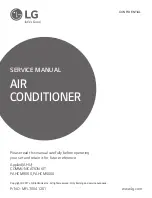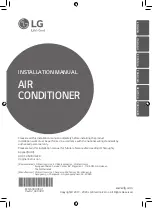
Page 29
3. Purge all air from the space heating loop
by closing the isolation valve on the return
leg of the loop and open the drain to
purge air. Open the return leg isolation
valve and then close the drain valve. If no
isolation valves are installed, open drain
fully to purge air and let run for at least 30
seconds.
4. Start the water heater or boiler according
to the manufacturer’s instructions. Set the
desired water temperature (140F/60C)
and wait for the tank to shut off.
5. Turn on the power to the air handler and
set the room thermostat for heat to
energize the fan and pump. If a gurgling
sound is present, it should subside within
one minute. If noise is still present after
one minute, repeat step 3 to purge air as
necessary.
6. Grab hold of the heating lines with your
hands to verify that they are getting
warmer due to the hot water circulating
through them. Also verify the circulating
pump is operating by feeling for the
vibrations. With the air handler running,
ensure water flow through the circulation
loop by measuring the water temperature
difference. It should be in the range of 10-
30°F temperature drop through the air
handler with an entering water
temperature between 135-180°F.
HINT: The temperature drop across the air
handler can easily be measured with a probe
type pocket thermometer. Wrap a rag or
piece of insulation around the inlet and outlet
of the heating coil to the air handler and
insert the thermometer probe between the
insulation and the pipe to take the reading.
Wait at approximately 2 minutes to take each
reading
(longer for systems with a storage
tank
). Make certain to take both readings one
immediately after the other. At high flow rates
the temperature in the tank may drift, causing
error in the calculated temperature difference,
if readings are taken more than 4 minutes
apart.
Ensure that all electrical connections are tight,
and that any packing or shipping restraints
are removed from both the fan coil, and the
condensing unit. With the power to the
condensing unit off, check the thermostat for
normal operation, and again check that there
is proper airflow from all the vents. Ensure
that no branch ducts were damaged or bent
sharply. Do not run the fan coil without a filter
in place.
DO
NOT
LEAVE THE SYSTEM
UNATTENDED UNTIL NORMAL
OPERATING CONDITIONS ARE OBTAINED.
Observe the condenser pressures during the
initial start-up of the system. Check the
voltage and amp draw of both the fan coil,
and the outdoor condensing unit. The
voltages must be within 10% of the rating
plate data. If more than a 10% difference is
noted, contact your local electrical company.
Check that the amprage draws on both the
air handler and condensing units are within
the information printed on the unit rating
plates. Set the refrigerant charge as required
for optimal performance.
DO NOT USE THE FAN COIL FOR
TEMPORARY HEAT DURING
CONSTRUCTION. THIS WILL VOID ALL
UNIT WARRANTIES
UNDERSTANDING THE ZONE CONTROLS
.
The z
oning controller
serves as the brains of
the zoning system. The zone controllers have
a built-in computer to monitor the thermostats
and the HVAC equipment, and to open and
close the dampers.
• The zone panel has a connection to hook
up thermostats.
Summary of Contents for MaxAir 100e P2
Page 43: ...Page 43 WIRING DIAGRAM P2 UNITS...
Page 44: ...Page 44 WIRING DIAGRAM P3 UNITS...
Page 45: ...Page 45 WIRING DIAGRAM P2 UNITS ALTERATIONS HEAT PUMP OPTION...
Page 46: ...Page 46 WIRING DIAGRAM P3 UNITS ALTERATIONS HEAT PUMP OPTION...
Page 51: ...Page 51 FAN COIL DIMENSIONS AND RETURN AIR SIZE LOCATION...
Page 52: ...Page 52...
Page 53: ...Page 53...
Page 54: ...Page 54...
Page 55: ...Page 55...
Page 56: ...Page 56...
Page 61: ...Page 61 2 AND 2 5 TON EVAPORATOR COIL SIZES 70 IPCE 24 30A...
Page 62: ...Page 62 SAMPLE PIPING SCHEMATICS...
Page 63: ...Page 63...
Page 64: ...Page 64...
Page 65: ...Page 65...












































